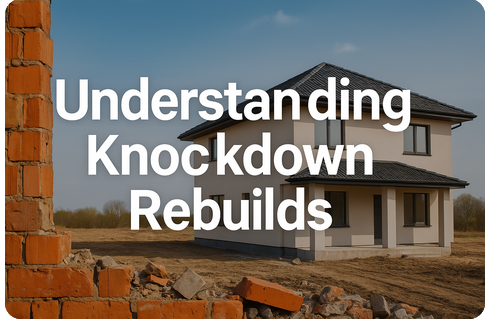Understanding Knock Down Rebuilds

Knock Down Rebuilds (KDR) have emerged as a popular solution for homeowners seeking to modernize their living spaces without relocating. This process involves demolishing an existing structure and constructing a new one on the same site, offering a fresh start while retaining the benefits of the original location. KDRs provide an opportunity to design a home tailored to contemporary needs and preferences, incorporating the latest architectural trends, energy-efficient technologies, and personalized features. This approach not only enhances the aesthetic and functional aspects of a property but also can significantly increase its market value. Understanding the intricacies of Knock Down Rebuilds, from planning and permits to construction and completion, is essential for homeowners considering this transformative option.
What Are The Benefits Of Knock Down Rebuilds?
Modernise Your Living Space
Knock down rebuilds (KDRs) have emerged as a compelling option for homeowners seeking to modernize their living spaces without the constraints of existing structures. This approach involves demolishing an old, often outdated house and constructing a new one on the same plot of land. The benefits of knock down rebuilds for modern living are manifold, offering a blend of contemporary design, enhanced functionality, and improved energy efficiency.
Design a home that perfectly aligns with current lifestyle needs and preferences
One of the primary advantages of opting for a knock down rebuild is the opportunity to design a home that perfectly aligns with current lifestyle needs and preferences. Unlike renovations, which are often limited by the existing framework, a KDR allows for complete freedom in architectural design. Homeowners can incorporate open-plan living areas, state-of-the-art kitchens, and luxurious bathrooms, all tailored to their specific tastes. This level of customization ensures that the new home is not only aesthetically pleasing but also highly functional, catering to the unique requirements of modern living.
Improvements energy efficiency
In addition to design flexibility, knock down rebuilds offer significant improvements in energy efficiency. Older homes are frequently plagued by poor insulation, outdated heating and cooling systems, and inefficient windows and doors. By constructing a new home, homeowners can integrate the latest advancements in building materials and technologies. This includes high-performance insulation, energy-efficient windows, and sustainable heating and cooling systems. Consequently, the new home is more environmentally friendly and cost-effective to maintain, leading to substantial savings on utility bills over time.
Enhance the value of the property
Furthermore, knock down rebuilds provide an excellent opportunity to enhance the overall value of the property. A newly built home, designed with contemporary standards and features, is likely to attract higher market value compared to an older, renovated property. This is particularly advantageous for homeowners considering future resale. The appeal of a modern, energy-efficient home can significantly boost its attractiveness to potential buyers, ensuring a better return on investment.
Remain in a familiar neighborhood
Another notable benefit of knock down rebuilds is the ability to remain in a familiar neighborhood. Many homeowners are deeply attached to their local communities, valuing the proximity to schools, workplaces, and social networks. A KDR allows them to enjoy the best of both worlds: a brand-new home without the need to relocate. This continuity is especially beneficial for families with children, as it minimizes disruption to their daily routines and maintains their established support systems.
Straightforward and cost-effective
Moreover, the process of a knock down rebuild can be more straightforward and cost-effective than extensive renovations. Renovations often uncover unforeseen issues, such as structural damage or outdated wiring, which can escalate costs and prolong timelines. In contrast, a KDR offers a clear and predictable path from demolition to construction, with fewer surprises along the way. This streamlined process can reduce stress and provide homeowners with a more accurate understanding of the project’s scope and budget.
In conclusion, the benefits of knock down rebuilds for modern living are substantial, encompassing design flexibility, energy efficiency, property value enhancement, community continuity, and a more predictable construction process. As homeowners increasingly seek to create living spaces that reflect contemporary standards and personal preferences, the appeal of KDRs continues to grow. By opting for a knock down rebuild, individuals can achieve a harmonious blend of modernity and familiarity, resulting in a home that truly meets the demands of today’s lifestyle.
Key Steps In The Knock Down Rebuild Process
| Step | What It Involves |
|---|
| 1. Site Assessment & Feasibility | Evaluate your block’s suitability (e.g., size, slope, access, council zoning). Check for overlays like bushfire, flood, or heritage controls. |
| 2. Design & Planning | Collaborate with your builder or designer to create a custom home plan that suits your lifestyle and complies with local regulations. |
| 3. Permits & Approvals | Submit documentation to obtain demolition permits, building approvals, and council planning clearance. |
| 4. Demolition | A licensed demolition contractor safely removes the old structure, clears the site, and disposes of waste. |
| 5. Site Preparation | Prepare foundations, including soil testing, excavation, retaining walls, or levelling if needed. |
| 6. Construction Begins | Your builder begins the new home construction, following agreed timelines, inspections, and quality checks. |
| 7. Final Handover | After completion and final inspections, you receive the keys to your brand-new, custom-built home. Celebrate and move in! |
Understanding the knock down rebuild process is essential for homeowners considering this transformative approach to property improvement. This method involves demolishing an existing structure and constructing a new one in its place, offering a fresh start without the need to relocate. To navigate this complex process successfully, it is crucial to comprehend the key steps involved, ensuring a seamless transition from the old to the new.
Assessment of the existing property
Initially, the process begins with a thorough assessment of the existing property and its potential for redevelopment. This involves engaging with professionals such as architects, builders, and surveyors to evaluate the structural integrity of the current building and the feasibility of a new construction. During this phase, it is also important to consider local zoning laws and regulations, which may impact the design and scope of the new build. By understanding these constraints early on, homeowners can avoid potential legal and logistical issues down the line.
develop a comprehensive design plan
Following the assessment, the next step is to develop a comprehensive design plan for the new structure. This stage requires close collaboration with architects and designers to create a blueprint that meets the homeowner’s needs and preferences while adhering to regulatory requirements. It is essential to consider factors such as layout, functionality, and aesthetic appeal, ensuring that the new build not only enhances the property’s value but also provides a comfortable and practical living space. Additionally, incorporating sustainable and energy-efficient features can contribute to long-term cost savings and environmental benefits.
Obtain the necessary permits and approvals
Once the design plan is finalized, obtaining the necessary permits and approvals is the next critical step. This process can be time-consuming and may involve multiple government agencies, depending on the location and scope of the project. Homeowners must be prepared to submit detailed documentation, including architectural drawings, engineering reports, and environmental impact assessments. Securing these permits is a prerequisite for commencing any demolition or construction work, underscoring the importance of meticulous preparation and adherence to regulatory standards.
Demolition phase
With permits in hand, the demolition phase can begin. This step involves safely dismantling the existing structure, which may require specialized equipment and expertise. It is essential to engage a reputable demolition contractor who can manage the process efficiently while minimizing disruption to the surrounding area. Proper disposal of debris and hazardous materials is also a critical consideration, ensuring compliance with environmental regulations and maintaining site safety.
Construction of the new building
Following demolition, the construction of the new building can commence. This phase involves a series of coordinated activities, including site preparation, foundation laying, framing, and installation of essential systems such as plumbing, electrical, and HVAC. Throughout this process, regular communication with the builder is vital to address any issues that may arise and to ensure that the project stays on schedule and within budget. Periodic inspections by local authorities may also be required to verify compliance with building codes and standards.
Finishing touches
As construction nears completion, the final steps involve finishing touches such as interior and exterior painting, landscaping, and installation of fixtures and fittings. A thorough inspection of the new build is essential to identify any defects or areas requiring attention before the homeowner takes possession. Once all issues are resolved, the property is ready for occupancy, marking the culmination of the knock down rebuild journey.
In conclusion, understanding the key steps in the knock down rebuild process is fundamental for homeowners seeking to undertake this ambitious project. From initial assessment and design planning to obtaining permits, demolition, construction, and final inspection, each phase requires careful consideration and expert guidance. By following these steps diligently, homeowners can achieve a successful transformation of their property, resulting in a modern, functional, and aesthetically pleasing new home.
Cost Considerations For A Successful Knock Down Rebuild
| Cost Category | Details |
|---|
| Demolition Costs | Includes removal of the existing home, site clearing, and disposal of waste. Budget around $15,000–$40,000, depending on site complexity. |
| Design & Planning | Covers architectural plans, engineering reports, and energy efficiency assessments. Some custom builds may include pre-construction consulting fees. |
| Council Fees & Permits | Includes planning applications, demolition permits, building approvals, and possible developer contributions or infrastructure levies. |
| Construction Costs | Main build cost, generally calculated per square metre. Custom homes often range from $2,500–$4,000+/m² depending on design and inclusions. |
| Site Preparation | Costs for soil testing, retaining walls, excavation, drainage, and access solutions—especially on sloping or narrow blocks. |
| Temporary Accommodation | Budget for rental or alternative living arrangements during the build (typically 6–12 months). |
| Landscaping & Driveways | Often excluded from the base build price—budget for fencing, turf, garden beds, and driveways. |
| Upgrades & Variations | Choosing higher-spec fixtures, custom finishes, or layout changes can increase costs. It’s wise to include a contingency buffer of 10–15%. |
When contemplating a knock down rebuild (KDR), it is essential to understand the various cost considerations that can significantly impact the success of your project. A knock down rebuild involves demolishing an existing structure and constructing a new one in its place, offering homeowners the opportunity to create a modern, customized living space without relocating. However, this process entails a range of financial factors that must be meticulously planned and managed to ensure a smooth and cost-effective execution.
Cost of demolition
To begin with, the initial cost of demolition is a primary consideration. Demolition expenses can vary widely depending on the size and complexity of the existing structure, as well as local regulations and requirements. It is crucial to obtain multiple quotes from reputable demolition contractors to ensure competitive pricing. Additionally, one must account for the disposal of debris, which can add to the overall cost. Properly budgeting for these preliminary expenses is vital to avoid unexpected financial strain.
Site preparation costs
Following the demolition phase, site preparation costs must be addressed. This includes clearing the land, leveling the site, and addressing any potential issues such as soil contamination or unstable ground conditions. These preparatory steps are essential for laying a solid foundation for the new build. Engaging a qualified site surveyor and geotechnical engineer can help identify and mitigate any potential challenges early on, thereby preventing costly delays and complications during construction.
Cost of building materials and labor
Transitioning to the construction phase, the cost of building materials and labor is a significant factor. The choice of materials, design complexity, and the quality of finishes will all influence the overall expenditure. It is advisable to work closely with an experienced architect and builder to develop a realistic budget that aligns with your vision and financial constraints. Furthermore, obtaining detailed quotes and contracts from all parties involved can help prevent cost overruns and ensure transparency throughout the project.
Expenses such as permits, inspections, and utility connections
In addition to direct construction costs, it is important to consider ancillary expenses such as permits, inspections, and utility connections. Securing the necessary permits and approvals from local authorities can be a time-consuming and costly process. Engaging a knowledgeable project manager or builder who is familiar with local regulations can streamline this process and help avoid potential fines or delays. Similarly, reconnecting utilities such as water, electricity, and gas to the new structure can incur additional costs that should be factored into the overall budget.
Temporary accommodation costs
Moreover, temporary accommodation costs should not be overlooked. During the knock down rebuild process, homeowners will need to arrange alternative living arrangements, which can range from renting a property to staying with family or friends. The duration of the construction phase will directly impact these expenses, making it essential to have a clear timeline and contingency plan in place.
A contingency fund
Finally, it is prudent to allocate a contingency fund to cover any unforeseen expenses that may arise during the project. Construction projects are inherently complex, and unexpected issues such as inclement weather, supply chain disruptions, or design modifications can lead to additional costs. A contingency fund of 10-15% of the total project budget is generally recommended to provide a financial buffer and ensure the project remains on track.
In conclusion, a successful knock down rebuild requires careful consideration of various cost factors, from demolition and site preparation to construction and ancillary expenses. By thoroughly planning and budgeting for each phase of the project, homeowners can achieve their dream home while minimizing financial risks and ensuring a smooth and efficient process.
If you’re considering a knockdown rebuild on the Sunshine Coast, Ward Builders is here to guide you every step of the way.
Read more about Knock Down Rebuilds:
- Understanding Knock Down Rebuilds
- Costs and Financing for Knock Down Rebuilds
- Finding the Right Location for Your Knock Down Rebuild
- Designing Your Dream Home with a Knock Down Rebuild
- Working with a Knock Down Rebuild Builder
- Permits and Regulations for Knock Down Rebuilds
- Demolition and Site Preparation for Knock Down Rebuilds
- Building Materials and Technology for Knock Down Rebuilds
- Interior Design and Finishing Touches for Knock Down Rebuilds
- Moving into Your New Home and Future Maintenance









